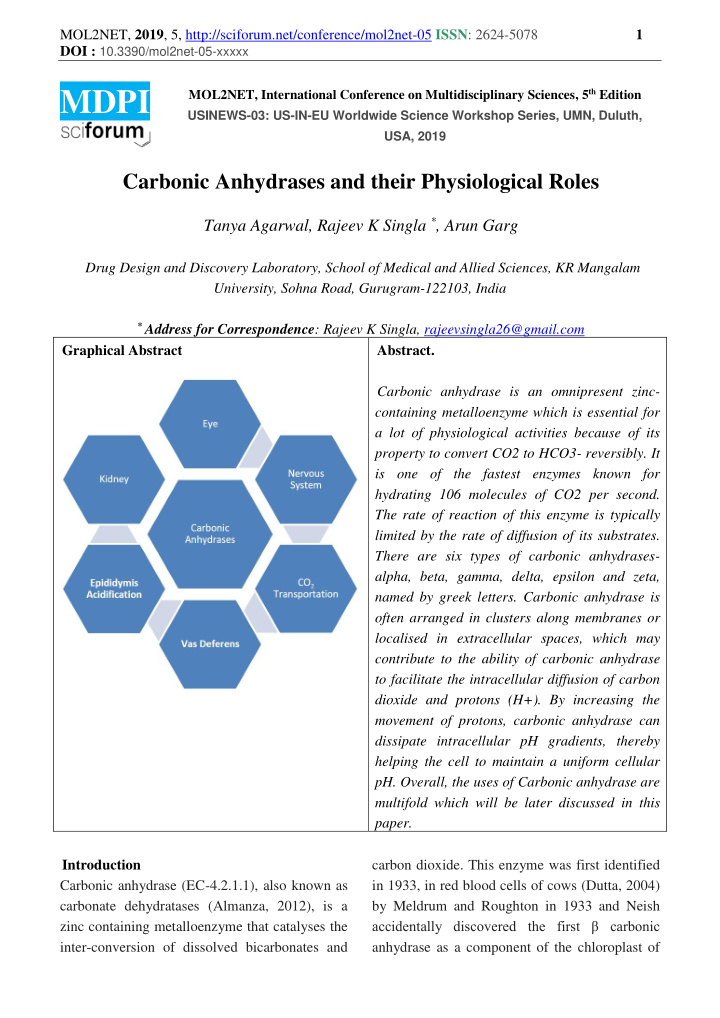



MOL2NET, 2019 , 5, http://sciforum.net/conference/mol2net-05 ISSN : 2624-5078 1 DOI : 10.3390/mol2net-05-xxxxx MOL2NET, International Conference on Multidisciplinary Sciences, 5 th Edition MDPI USINEWS-03: US-IN-EU Worldwide Science Workshop Series, UMN, Duluth, USA, 2019 Carbonic Anhydrases and their Physiological Roles Tanya Agarwal, Rajeev K Singla * , Arun Garg Drug Design and Discovery Laboratory, School of Medical and Allied Sciences, KR Mangalam University, Sohna Road, Gurugram-122103, India * Address for Correspondence : Rajeev K Singla, rajeevsingla26@gmail.com Graphical Abstract Abstract. Carbonic anhydrase is an omnipresent zinc- containing metalloenzyme which is essential for a lot of physiological activities because of its property to convert CO2 to HCO3- reversibly. It is one of the fastest enzymes known for hydrating 106 molecules of CO2 per second. The rate of reaction of this enzyme is typically limited by the rate of diffusion of its substrates. There are six types of carbonic anhydrases- alpha, beta, gamma, delta, epsilon and zeta, named by greek letters. Carbonic anhydrase is often arranged in clusters along membranes or localised in extracellular spaces, which may contribute to the ability of carbonic anhydrase to facilitate the intracellular diffusion of carbon dioxide and protons (H+). By increasing the movement of protons, carbonic anhydrase can dissipate intracellular pH gradients, thereby helping the cell to maintain a uniform cellular pH. Overall, the uses of Carbonic anhydrase are multifold which will be later discussed in this paper. Introduction carbon dioxide. This enzyme was first identified Carbonic anhydrase (EC-4.2.1.1), also known as in 1933, in red blood cells of cows (Dutta, 2004) carbonate dehydratases (Almanza, 2012), is a by Meldrum and Roughton in 1933 and Neish accidentally discovered the first β carbonic zinc containing metalloenzyme that catalyses the inter-conversion of dissolved bicarbonates and anhydrase as a component of the chloroplast of
MOL2NET, 2019 , 5, http://sciforum.net/conference/mol2net-05 ISSN : 2624-5078 2 DOI : 10.3390/mol2net-05-xxxxx first class, the α -CA, was discovered in the the plant leaf in 1939 (Almanza, 2012). Carbonic 1930′s in vertebrates. The second class, the beta - anhydrase is one of the fastest enzymes known CA, was discovered in the 1990′s in plants for hydrating 106 molecules of CO 2 per second. The rate of reaction of this enzyme is typically (DiMario et al, 2018). A third group was limited by the rate of diffusion of its substrates identified in archaebacteria in 1994. The latest CA families, t he η - CAs and the θ -CAs, were (Bhat et al, 2017). The carbonic anhydrase reaction is involved in many physiological and discovered in 2015 and 2016 respectively. Each pathological processes, including respiration and protein family is phylogenetically unrelated to transport of CO 2 and bicarbonate between the others (DiMario et al, 2018). metabolizing tissues and lungs, pH and CO 2 homeostasis, electrolyte secretion in various 1. ALPHA TYPE The α -class is found throughout the animal tissues and organs, biosynthetic reactions (such as gluconeogenesis, lipogenesis and kingdom, in the periplasm (Bhat et al, 2017). The ɑ -carbonic anhydrases are widely identified in ureagenesis), bone resorption and calcification (Supuran, 2018). Species can produce many vertebrates, algae and in eubacteria (Bhat et al, different carbonic anhydrase isozymes, some of 2017). They were the first class of carbonic which act in the cytosol, while others are anhydrases which were isolated from membrane-bound. For instance, in humans there erythrocytes. They are distinct from all other are five cytosolic isozymes (I, II, III, VII and carbonic anhydrase classes in both protein XIII) (Supuran, 2018), five membrane-bound structure and amino acid sequence (DiMario et isozymes (IV, VII, IX, XII and XIV), two al, 2018). The protein structure includes a central β - sheet consisting of ten β -strands surrounded by mitochondrial isozymes (VA and VB), and a seven peripheral α - helices. The β -sheet acts as secreted salivary isozyme (VI), as well as several related proteins that lack catalytic the active site of carbonic anhydrase. It activity. Carbonic anhydrases are often arranged coordinates the zinc atom with three histidine in clusters along membranes or localised in residues and a water molecule (DiMario et al, extracellular spaces, which may contribute to the 2018). ability of carbonic anhydrase to facilitate the The CA enzymes found in mammals are divided intracellular diffusion of carbon dioxide and into four broad subgroups, which, in turn consist protons (H + ). By increasing the movement of of several isoforms: protons, carbonic anhydrase can dissipate • T he cytosolic CAs (CA-I, CA-II, CA-III, CA- intracellular pH gradients, thereby helping the VII and CA XIII) cell to maintain a uniform cellular pH. Carbonic anhydrases can also create localised gradients, • M itochondrial CAs (CA-VA and CA-VB) which may aid in processes such as facilitated • secreted CAs (CA -VI) diffusion across a membrane. • M embrane-associated CAs (CA-IV, CA-IX, Types of Carbonic Anhydrase CA-XII, CA-XIV and CA-XV) There is a wide variety of carbonic anhydrase proteins that fall into a number of protein There are three additional acatalytic CA isoforms (CA-VIII, CA-X, and CA-XI) whose functions families. These families are named by Greek are unclear (Hunter, 2018). letters and roughly follow the order in which they were discovered (DiMario et al, 2018). The
Recommend
More recommend